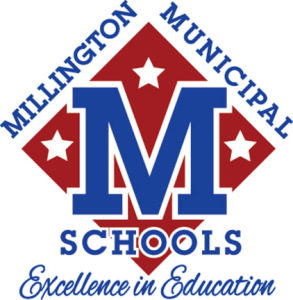By Bill Short
 In response to a request by the superintendent, the Millington School Board has unanimously approved an additional bus route for students attending Millington Elementary School. Board members took the action during their Dec. 1 regular monthly meeting on a motion offered by Cody Childress and seconded by Larry Jackson. Dr. David Roper, director of Millington Municipal Schools, said that after examining “some issues” related to student safety and welfare, he determined that an additional bus route is necessary. Roper noted that the bus will pick up and drop off students who live in the Martinwest subdivision on the south side of Navy Road. He called that a “very difficult road” to ask students to cross, even with the assistance of a crossing guard. “We certainly want to be extremely watchful for the welfare and the safety of all students,” he said. “And, especially, with our younger elementary students, who sometimes do not appreciate the dangers that are existing on a major thoroughfare like that.” Roper noted that, in its budget for the 2014-15 academic year, the school system initially allocated $1,432,000 for transportation cost. But because of “consolidation of routes,” that amount has been reduced to $1,267,000. Although the estimated cost of adding this one bus for one full year is approximately $40,000, he said it will cost about $23,000 for the remainder of the current fiscal year. Roper also noted that, to serve “special needs” students for a Special Education program, the Millington school system has begun an “arrangement” to “split” a bus route with Bartlett. And the “payment” that Bartlett makes will save Millington “about half” of the $40,000 annual cost. “So, the net bottom line will be approximately an additional $20,000 instead of $40,000,” he said. “We think that’s certainly well worth the assurances we’ll have that our students’ safety is kept.” In response to a question by board Chairman Don Holsinger, Roper said the additional bus route will also cover the mobile home park behind the Martinwest subdivision. Board member Louise Kennon called it “a great idea,” because the children who live in that area get “wet and cold” during the winter. In response to a question by Childress, Roper acknowledged that the area is “slightly under” the 1.5-mile “boundary.” But he noted that a “precedent” already exists for transporting some students to E. A. Harrold Elementary School to “avoid them crossing” Highway 51 and some other major thoroughfares. “We are allowed to take students’ safety into consideration for those kinds of situations,” he said. “And so, we felt like this was one of those situations that warrants that.” Regarding the additional bus route, Holsinger said he believes the sidewalk adjacent to the Navy property is actually a “drainage ditch.” When it rains, he said, that fills with water, and the students probably have to walk in the street. “They walk through the water,” Kennon noted. Childress acknowledged that there has been “turmoil and controversy” over the 1.5-mile requirement for years. So, he asked how the additional bus route will affect the transportation “reimbursement” that the school system receives from the state. Oscar Brown, supervisor of Operations and Transportation for the school district, said he was told that the state will not reimburse it for the transportation of that route, because the area is less than 1.5 miles from Millington Elementary. “Even if the sidewalk is determined to be a drainage ditch,” Childress asked, “and the children don’t have safe passage?” “I haven’t asked the specific question whether a safety issue will overrule that,” Brown replied. “But I will look into the safety part of it and see if that is a consideration.” Bruce Rasmussen, supervisor of Financial Services for the district, said the “flat rate” it receives from the state for transportation is based on the Basic Education Program numbers and the number of students who live more than 1.5 miles from the school they attend. “You don’t have to comply with the mile and a half,” he noted. “You can make it 2 miles or 1 mile. But that’s all the money that the state will give you.” Because he questioned whether one additional bus will be sufficient, board Vice Chairman Greg Ritter asked how many students it will be transporting. While noting that the “largest bus capacity” for an elementary school route is 72 students, Brown said he was told that this route will have 59. “So, we should be able to get all those students on one bus,” he concluded. “If, for some reason we cannot, we can send another bus through there that would have five or 10 seats available to pick up some additional students.” In response to another question by Childress, Brown said the Bartlett school that Millington will “split” the bus route with has an 8 a.m. daily start time, while the Millington Elementary school day begins at 7 a.m. So, he said the bus will be able to complete Millington’s “first-tier run” and still have time to do the “second-tier” in Bartlett.
In response to a request by the superintendent, the Millington School Board has unanimously approved an additional bus route for students attending Millington Elementary School. Board members took the action during their Dec. 1 regular monthly meeting on a motion offered by Cody Childress and seconded by Larry Jackson. Dr. David Roper, director of Millington Municipal Schools, said that after examining “some issues” related to student safety and welfare, he determined that an additional bus route is necessary. Roper noted that the bus will pick up and drop off students who live in the Martinwest subdivision on the south side of Navy Road. He called that a “very difficult road” to ask students to cross, even with the assistance of a crossing guard. “We certainly want to be extremely watchful for the welfare and the safety of all students,” he said. “And, especially, with our younger elementary students, who sometimes do not appreciate the dangers that are existing on a major thoroughfare like that.” Roper noted that, in its budget for the 2014-15 academic year, the school system initially allocated $1,432,000 for transportation cost. But because of “consolidation of routes,” that amount has been reduced to $1,267,000. Although the estimated cost of adding this one bus for one full year is approximately $40,000, he said it will cost about $23,000 for the remainder of the current fiscal year. Roper also noted that, to serve “special needs” students for a Special Education program, the Millington school system has begun an “arrangement” to “split” a bus route with Bartlett. And the “payment” that Bartlett makes will save Millington “about half” of the $40,000 annual cost. “So, the net bottom line will be approximately an additional $20,000 instead of $40,000,” he said. “We think that’s certainly well worth the assurances we’ll have that our students’ safety is kept.” In response to a question by board Chairman Don Holsinger, Roper said the additional bus route will also cover the mobile home park behind the Martinwest subdivision. Board member Louise Kennon called it “a great idea,” because the children who live in that area get “wet and cold” during the winter. In response to a question by Childress, Roper acknowledged that the area is “slightly under” the 1.5-mile “boundary.” But he noted that a “precedent” already exists for transporting some students to E. A. Harrold Elementary School to “avoid them crossing” Highway 51 and some other major thoroughfares. “We are allowed to take students’ safety into consideration for those kinds of situations,” he said. “And so, we felt like this was one of those situations that warrants that.” Regarding the additional bus route, Holsinger said he believes the sidewalk adjacent to the Navy property is actually a “drainage ditch.” When it rains, he said, that fills with water, and the students probably have to walk in the street. “They walk through the water,” Kennon noted. Childress acknowledged that there has been “turmoil and controversy” over the 1.5-mile requirement for years. So, he asked how the additional bus route will affect the transportation “reimbursement” that the school system receives from the state. Oscar Brown, supervisor of Operations and Transportation for the school district, said he was told that the state will not reimburse it for the transportation of that route, because the area is less than 1.5 miles from Millington Elementary. “Even if the sidewalk is determined to be a drainage ditch,” Childress asked, “and the children don’t have safe passage?” “I haven’t asked the specific question whether a safety issue will overrule that,” Brown replied. “But I will look into the safety part of it and see if that is a consideration.” Bruce Rasmussen, supervisor of Financial Services for the district, said the “flat rate” it receives from the state for transportation is based on the Basic Education Program numbers and the number of students who live more than 1.5 miles from the school they attend. “You don’t have to comply with the mile and a half,” he noted. “You can make it 2 miles or 1 mile. But that’s all the money that the state will give you.” Because he questioned whether one additional bus will be sufficient, board Vice Chairman Greg Ritter asked how many students it will be transporting. While noting that the “largest bus capacity” for an elementary school route is 72 students, Brown said he was told that this route will have 59. “So, we should be able to get all those students on one bus,” he concluded. “If, for some reason we cannot, we can send another bus through there that would have five or 10 seats available to pick up some additional students.” In response to another question by Childress, Brown said the Bartlett school that Millington will “split” the bus route with has an 8 a.m. daily start time, while the Millington Elementary school day begins at 7 a.m. So, he said the bus will be able to complete Millington’s “first-tier run” and still have time to do the “second-tier” in Bartlett.
“I think this is one of the best decisions we have made,” Holsinger concluded. “It’s the smartest decision we could have made for the kids’ safety.”




